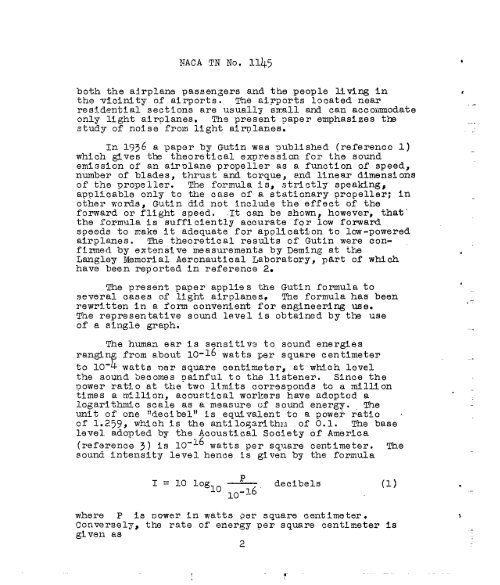The Problem of Noise Reduction with Reference ... - CAFE Foundation
The Problem of Noise Reduction with Reference ... - CAFE Foundation
The Problem of Noise Reduction with Reference ... - CAFE Foundation
Create successful ePaper yourself
Turn your PDF publications into a flip-book with our unique Google optimized e-Paper software.
oth the airplane passengers and the people living inthe -71cinity <strong>of</strong> airports. <strong>The</strong> airports located nearresidential sections are usually sw.alland can accolimnodateonly light airplanes. <strong>The</strong> present ?aper emphasizes tkestudy <strong>of</strong> noise from light airplanes.In 1936 a ‘paper by Gut5-nwas published (reference 1)which gives tke theoretical expression. for the soundemission <strong>of</strong>’an airolane propeller as a function OJ?speed,number <strong>of</strong> blades, thrust and torque, end linear dimensions<strong>of</strong> the propeller. <strong>The</strong> formula is, strictly speaking~applicable only to the case <strong>of</strong> a stationary propeller; inother words, Gutin did not include the effect <strong>of</strong> theforward or flight speed. It can be shown, however, that’the formula is sufficiently accurate for low forwardspeeds to make it adequate for application to low-poweredairplanes. <strong>The</strong> theoretical results <strong>of</strong> Gutin were confirmedby extens!.ve measurements by Deming at theLangley Memorial Aeronautical Laboratory, part <strong>of</strong> whichhave been reported in reference 20<strong>The</strong> present paper appliss the Gutin formula toseveral cases <strong>of</strong> light airplanes~ <strong>The</strong> formula has beenrewritten in a form convenient for engineering use.<strong>The</strong> representative sound level 5s obtained by the use<strong>of</strong> a single graph.<strong>The</strong> human ear is sensitive to sound energiesrangi lrom about 10-16 watts per square centimeterto lo-Ywatts ner square centimeter, at which Iovelthe sound becomes painful to the listener. Since thepower ratio at the two llmi.ts corresponds to a milliontimes a million, aco~~tic~l workers have adopted alogarithmic scale as a maasure ~f soUnd energy. <strong>The</strong>unit <strong>of</strong> one ‘*decibel”is equivalent to a power r“atio<strong>of</strong> 1.259, which is the antilogarithm <strong>of</strong> 0.1. <strong>The</strong> baselevel. adopted by the Acoustical Society <strong>of</strong> America.(reference 3) is 10-16 watts per square centimeter. <strong>The</strong>sound intensity level hence is given by the formula.c,.-I = 10 loglo —-lo~~6decibels(1).—where P is Dower in watts per square centimeter.Conversely, the rate <strong>of</strong> energy per square centlm.eter isgiven as9L
















